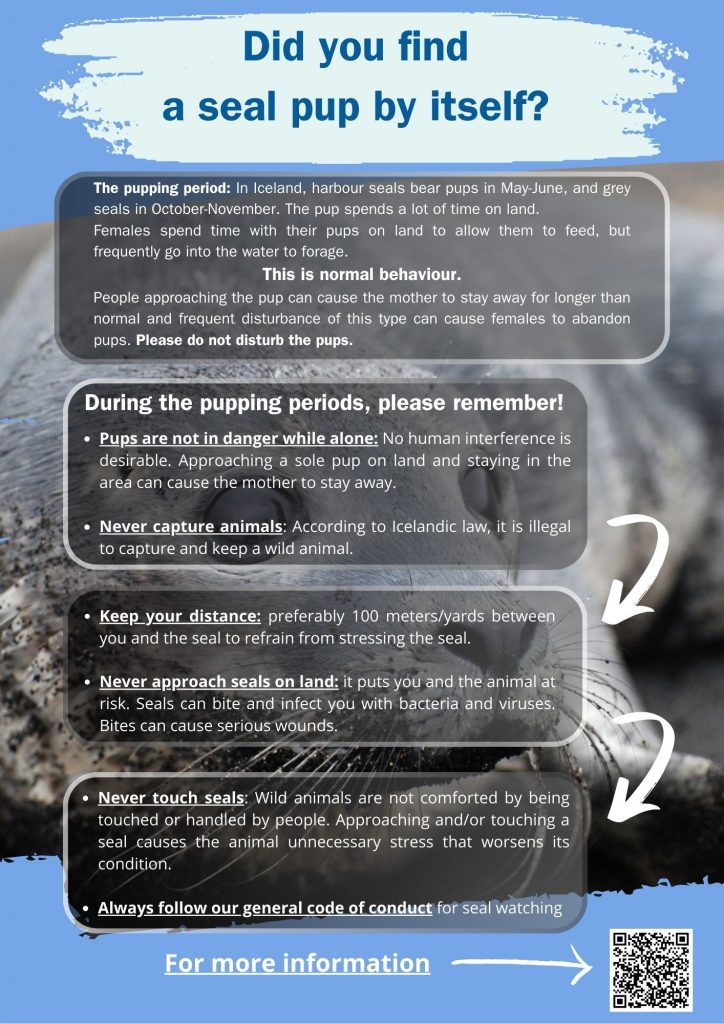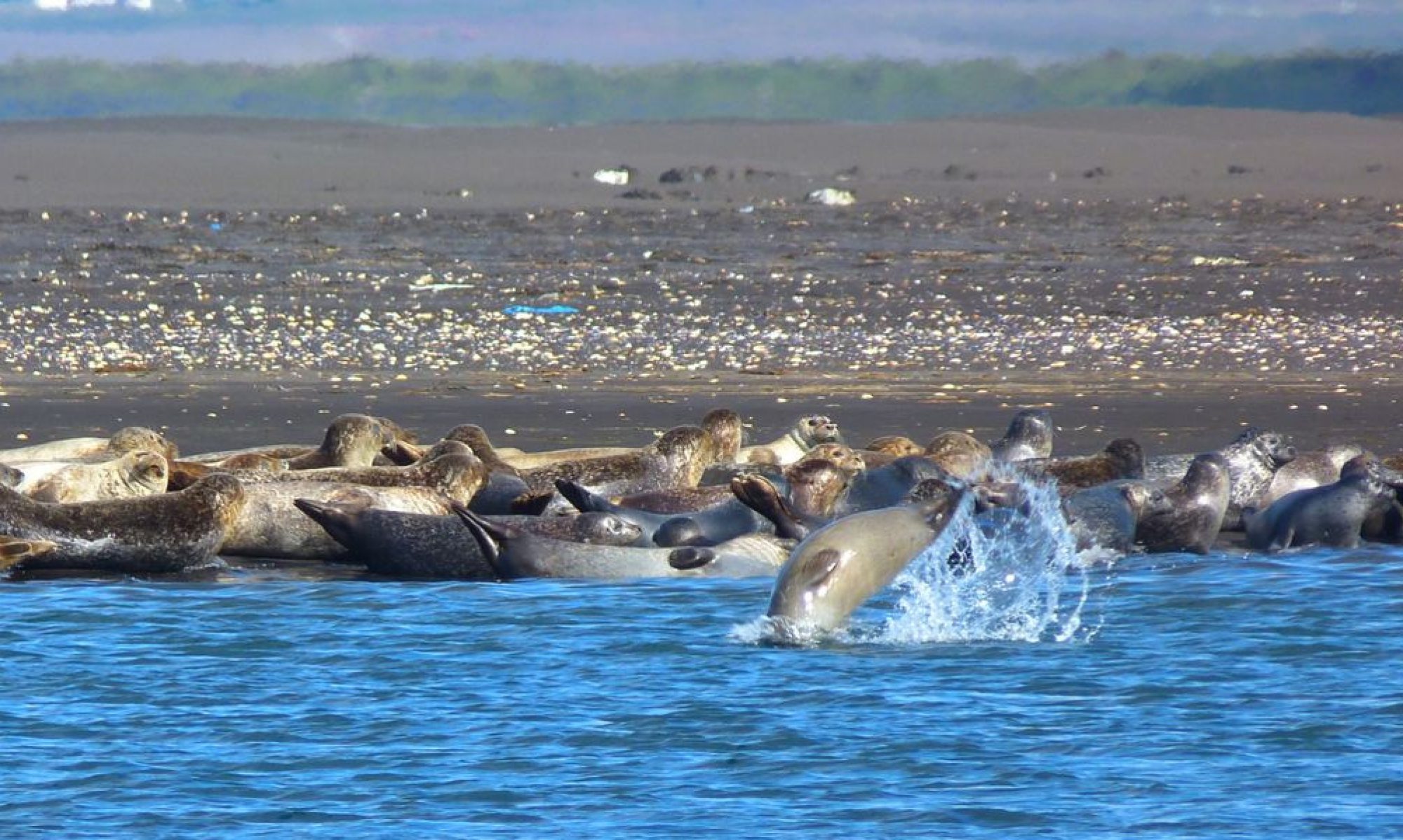
What to do if you find a seal that you think is suffering
If you find an animal that you think is suffering (bleeding, entangled etc):Your only option and responsibility is to report it.
Inform the nearest municipality.
If outside of opening hours, contact the nearest police precinct. These authorities will consult with the veterinarian on duty. If the seal is in Húnaþing vestra (between Blönduós and Hólmavík), call: 455 2400 or, if outside of normal business hours, call the local police precinct: 455 2666.
Inform the research department of the Icelandic Seal Center.
It is helpful to us if you can photograph the seal that you are worried about and send us the photos (and the GPS coordinates if possible). Our phone number is 451 2345.
Please remember!
- Never try to capture or touch the animal. Keep a distance of 100 meters/yards.
- Never capture animals: According to Icelandic law, it is illegal to capture and keep a wild animal.
- Keep your distance—preferably 100 meters/yards between you and the seal. The greater the distance between you and the seal, the less stress you cause the seal.
- Never approach seals on land—it puts you and the animal at risk: Seals can bite if they have the energy to do so. Bacteria and viruses on the skin and in the mouth of seals can infect you with disease. Bites can cause bleeding, bruising, and even broken bones.
- Never touch seals: Wild animals are not comforted by being touched or handled by people. Approaching and/or touching a seal causes the animal unnecessary stress that worsens its condition.
- Pups are usually not in danger while alone. No human interference is desirable. Approaching a sole pup on land and staying in the area can cause the mother to abandon the pup or to stay away longer than she normally would between feedings.
- Keep calm in the vicinity of seals: Move gently, keep your voice down, and never throw objects. Move away if seals show signs of disturbance: head up/vigilance or fleeing.
More information
If you find a seal you think is suffering, please remember that your only option is to report it (see above). Never try to approach a seal yourself since the safety of you and the seal will be in jeopardy. Seals may well bite if cornered and captured. A bite or scratch from a seal can induce serious infection or illness. Seals should be thought of as wild predators and should be left to their own devices. On the other hand, the safety and well-being of the seal is important to consider. As a wild animal, a seal is not used to or interested in being handled. The following text is intended as a guide to help you know what to do if you encounter a seal that you think is in trouble. This includes seals that are obviously hurt or sick and animals that are trapped in netting or other man-made objects.
When is a seal suffering and what is their natural behaviour?
Nature is indifferent to the survival of any individual and occasionally, people will see a seal that is unlikely to survive. There are many reasons that a pup might be abandoned, or a grown seal might be hurt or sick. The following information is intended to help you to understand what the best course of action is to ensure the well-being of the seals. While this is specifically about Icelandic seals (especially those on the Vatnsnes Peninsula), these suggestions could easily apply widely to our interactions with wild animals in other places.
The pupping period: Harbour seals in Iceland bear pups in May and early June. Grey seals bear their pups in October and November. For the first few weeks of life, the pup spends a lot of time on land. The female needs to maintain her own health and energy, so she goes into the water to forage and will frequently haul out (crawl up onto land) to allow her pup to feed. Harbour seal pups can swim shortly after birth and will sometimes, but not always, accompany the female when she goes into the ocean. Grey seal pups do not usually swim much until they have moulted the white pup fur and grown their adult fur, so they do not follow their mother on her foraging trips. This is entirely normal behaviour. If people approach a pup, it can cause the mother seal to remain in the water for longer than she would normally be away from her pup, interrupting their feeding rhythm and frequent disturbance of this type can cause a mother seal to abandon her pup before it is ready to be on its own.
Seals’ natural behaviour on land: Seals usually appear lazy when on land. They are typically lying on the shore to feed a pup, rest, or to allow their hair and skin to dry during the moulting period. They will often appear to fall asleep on land, lying motionless for long periods. This is not a sign of sickness, starvation, or injury. Pups most often remain calm when on land unless something is disturbing them. This low energy lifestyle allows them to grow and to develop necessary blubber quickly.
Since the seals spend time on land to rest, it’s very important to take care not to disturb them. Therefore, you should always ensure to keep a distance of 100 m (100 yards)—about the length of a football field—between you and any seal on land. Seals do not know that we do not mean any harm and they see us as a likely threat, responding accordingly. This distance is generally thought to be enough that the seal will not suffer undue stress. In some locations, seals have grown accustomed to people being closer than this and no longer flee at our approach. This is a change in natural behaviour that should be avoid. The natural flight response of these animals keeps them safer in the wild. While it can be perceived as fun to see them up close like that, losing this natural wariness can be quite detrimental to the seal. While the effect of a single person getting close one time is very little, remember that you are just one of over a hundred thousand people likely to visit Vatnsnes in any given year. We must consider the cumulative effect of all of us and let that steer our behaviour to reduce our negative impact on the natural world.
For further information on how to behave around seals, the full ISC Code of Conduct for wildlife watching can be found with the QR code or link below:


